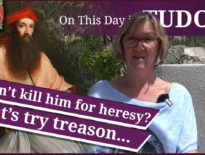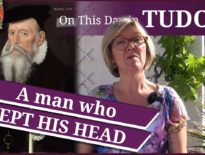On this day in Tudor history, 4th May 1535, in the reign of King Henry VIII, three Carthusian monks, a Bridgettine monk and a parish priest were executed at Tyburn.
They were executed for refusing to accept the King as the Supreme Head of the Church and “for writing and giving counsel against the King”, and had to suffer a full traitor's death, one after the other.
Find out more about them and also London Charterhouse, home to the Carthusian order, in today's talk.
Also on this day in Tudor history, 4th May 1513, the execution of claimant Edmund de la Pole, 8th Earl of Suffolk. Find out more about him and his brother, Richard, in last year’s video:
And in 1536, the imprisoned George Boleyn, Lord Rochford, brother of Queen Anne Boleyn, received a message of comfort from his wife, Jane Boleyn. Find out more about this event in the fall of Anne Boleyn, in my 4th May 1536 video:
Videos on the Carthusian martyrs:
Also on this day in history:
- 1471 – Death of Edward of Westminster, Prince of Wales and only son of Henry VI, at the Battle of Tewkesbury.
- 1536 – Arrests of Sir Francis Weston and Sir William Brereton during the fall of Anne Boleyn. They were both taken to the Tower of London.
- 1608 – Funeral of Elizabeth Talbot (Bess of Hardwick), Countess of Shrewsbury, in All Hallows, Derby. At the time of her death, she was one of the richest people in England.
Transcript:
On this day in Tudor history, 4th May 1535, in the reign of King Henry VIII, three Carthusian monks, a Bridgettine monk and a parish priest were executed at Tyburn.
The men were John Houghton, Robert Lawrence and Augustine Webster, respectively priors of the London Charterhouse, Beauvale [Boe-vel] and Axholme – and a Bridgettine monk, Richard Reynolds of Syon Abbey. They were executed for refusing to accept the King as the Supreme Head of the Church and “for writing and giving counsel against the King”. Their deaths are recorded in Letters and Papers (in a report from the Vatican Archives):
“First, the “said” four monks and one of the secular priests (because the young man [Robert Feron, Curate of Teddington] was pardoned) were drawn from the Tower of London to the place of execution (about a French league distant) and without respect for their Order hanged with great ropes. While they were still alive the hangman cut out their hearts and bowels and burned them. Then they were beheaded and quartered, and the parts placed in public places on long spears. And it is believed that one saw the other’s execution fully carried out before he died,—a pitiful and strange spectacle, for it is long since persons have been known to die with greater constancy. No change was noticed in their colour or tone of speech, and while the execution was going on they preached and exhorted the bystanders with the greatest boldness to do well and obey the King in everything that was not against the honor of God and the Church.”
Between 1535 and 1536, eighteen Carthusian monks were executed and I’ll give you links to my videos on some of them.
By the way, if you visit London, then do add London Charterhouse to your itinerary. Charterhouse was home to the Carthusian monks who suffered in Henry VIII’s reign, but it also has other Tudor links. After it was dissolved in the 1530s, it passed through the hands of Sir Edward North; John Dudley, Duke of Northumberland; Thomas Howard, 4th Duke of Norfolk; Philip Howard, 13th Earl of Arundel; Elizabeth I; Thomas Howard, Earl of Suffolk, and Thomas Sutton. And Elizabeth I visited it on several occasions. It is open to the public and its museum, which also tells of the site’s history as a burial site for victims of the Black Death in the 14th century, is wonderful to visit. The chapel there used to be the monks’ chapterhouse, and it was where the monks were asked to sign the oath to Henry VIII. After praying about it, they refused. Anyway, do add it to your list of must-sees.



Leave a Reply